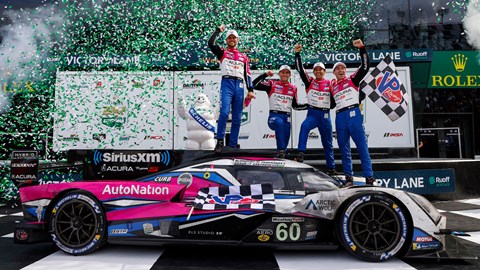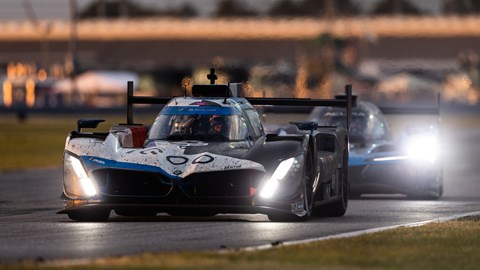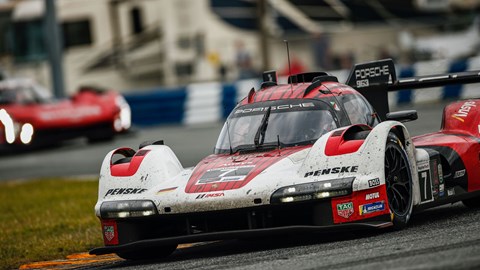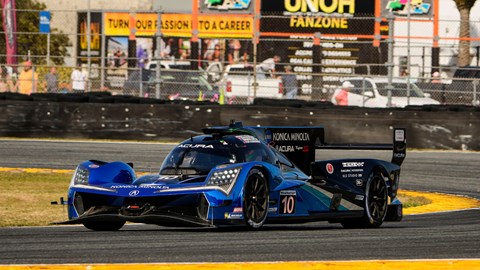► Porsche, BMW, Acura and Cadillac in action
► The first race for the new LMDh or GTP cars
► The future’s bright
The Hypercar era has begun – sort of. Although no actual Hypercars were present in this weekend’s 24 hour race, we did get our first look at the new LMDh machines that’ll be racing alongside them. Cheaper, lighter and more restricted in technology than the Hypercar regulations, the LMDh rules have attracted the lion’s share of car makers: Porsche, Acura, Cadillac and BMW all entered at least two new cars at the Rolex 24. As for the rest? They’ll be joined by Ferrari, Peugeot and Toyota Hypercars in the WEC series – and Le Mans – later this year.
And one more thing, although they’re often referred to as LMDh cars, because this is an IMSA event and not a WEC round, the new hybrids were classed as GTP cars – short for GT prototype. Confusing, isn’t it? Still, at least we have new cars and investment from car brands – that’s always a good thing

The #60 Meyer Shank Racing Acura ARX-06 of Tom Blomqvist, Colin Braun, Hélio Castroneves and Simon Pagenaud ultimately won – but what was our first taste of Le Mans’ new hybrid era like? Was it Group C reborn, a fiery mess, or just LMP2 but with better liveries and drivers you’re more likely to have heard of? Keep reading to find out more.
1. Endurance racing is always good
Before we get into just how the new LMDh cars fared, it’s worth remembering that they’re just leading actors of a diverse cast. As always seems to be the case in endurance racing, there were intense battles throughout the field, with caution periods and mechanical issues routinely balancing the scales and resetting battles across the LMP2, LMP3 and GT fields. The highlight had to be the LMP2 race, which saw first and second separated at the line by just 0.016 seconds.
2. It’s an exciting time
The motorsport industry can change at a moment’s notice; just look at Honda’s constant dipping in and out of F1. Sometimes a series looks dead only for it to be rejuvenated, while other times it goes from abundance to feast to famine in just a few years – think DTM here.
This year’s Rolex 24 felt like a step toward the Group C days – but without the unsustainable budgets, rocket fuel-powered engines, or aviating aero. For the last few years, motorsport fans would be forgiven for thinking the days of grids packed with road car manufacturers had passed – but a growing Le Mans entry list proves otherwise.

3. The cars do look different
Le Mans prototypes tend to look pretty similar, so it was a relief to see just how different the GTP grid looked at the Daytona Speedway. The Porsche 963 has the same four-pointed lights we’ve come to expect from Stuttgart, while the BMW V8 M Hybrid car has the same gaping grilles as its road cars. The trio of Cadillacs also bared a resemblance to the brand’s other products – and the Acura’s bridge wing made it interesting enough, even if it doesn’t look like your average Civic or NSX. Trying to recreate the look and feel of different brands was a key part of the LMDh mission statement, and it’s one on the series certainly has delivered on.
4. There’s already an all-star cast
To take part in the Daytona 24 on any level, you need to be good – but to drive a multi-million work in progress from the likes of Porsche to Acura – you need to be the cream of the crop. With that in mind, the GTP field is a who’s who of racing with the likes of Nick Tandy, Hélio Castroneves, Tom Blomqvist, Sebastian Bourdais, Alexander Sims and many more. The sheer level of skill meant that the GTP racing was largely clean, with room and respect given at all times – unlike some series. What’s more, it also meant we got to see the new hybrid cars pushed to their limits for all 24 hours.

5. The cars sound different
The Balance of Performance loomed over this race just as it does with every other endurance race – but it’s a necessary evil if we’re to have such a diverse range of technology. Each LMDh car is unique both inside and outside, as each brand has gone down a slightly different powertrain path. Only the hybrid gear itself is spec, everything around it is designed by each manufacturer – and even then, the way in which the hybrid tech is packaged and then deployed in the lap varies between each car.
The Porsche uses a forced-induction, flatplane 4.6-litre V8 derived from its 918 road car, while the Cadillac predictably uses an even chunkier 5.5-litre, naturally-aspirated crossplane V8 block. Think NASCAR and you’re pretty much there when it comes to the Caddy. It’s the only NA engine of the GTP cars, and it’s thunderous.

The Acura uses a twin-turbo V6 which sounds a lot more like the classy hybrid sound of contemporary F1 cars, while the BMW uses a 4.0-litre V8 twin-turbo block, derived from its DTM powerplants in 2017 and 2018.
6. Reliability is… mixed
Although each car has already done thousands of miles in testing, this was the first time the GTP field has raced in anger. As you’d expect from new cars – especially those with hybrid systems – there were mechanical hiccups, though not as many as you’d think.
Of the new GTP cars, both Penske Porsches and one of the BMWs spent time in the garage; one 963 had a gearbox issue with the other having a hybrid problem, while the BMW M V8 Hybrid had a hybrid issue of its own.

Both Acuras – including the winning car – had a gearbox seal issue that continued to the finish, and both Cadillacs managed to complete all 24 hours without any technical problems.
One thing is clear, both Porsche and BMW have work to do.
7. Acura is looking good
After a strong performance in qualifying, the Meyer Shank Racing Acura went on to convert its pole position to a win on race day. Throughout the race, both Acuras looked to have a solid pace advantage against the competition. When compared to the Cadillacs that followed them home, the Acuras looked to have the pace in both the twisty, infield sections as well as the power-dependent straights.
The pace difference between the Porsche and the Acura was more subtle, with the 963’s problems ultimately putting both out of contention. When they were racing on track, however, both cars were evenly matched. However, the Acuras seemed a touch faster, most notably when they were able to blast onto the long Daytona straight with far more traction. They also appeared to have a higher top speed.
8. But we don’t really know anything
The Daytona 24 was more of a test than a race for the current GTP cars, with races in Sebring and later Le Mans framed as more significant milestones. With so much development still to do, there’s more than enough room for a change in the current pecking order – and reliability is also still a factor.
More uncertain still is where these GTP or LMDh cars will sit when compared to the Hypercars from Ferrari, Glickenhaus, Peugeot and Toyota. Even if the Balance of Performance does a proper job of matching the pace of the two classes, they’ll be making their laptime in a vastly different way. Le Mans 2023 is going to be fascinating.